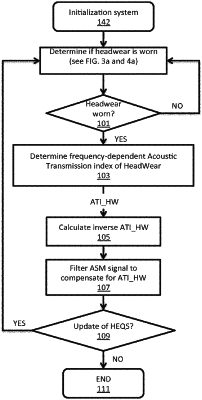| CPC H04R 1/1083 (2013.01) [G01H 3/00 (2013.01)] | 30 Claims |

|
1. An earbud comprising:
a first Ambient Sound Microphone (ASM), wherein the first ASM generates a first ASM signal;
a second ASM, wherein the second ASM generates a second ASM signal;
an ear canal microphone (ECM), wherein the ECM generates an ECM signal;
a speaker;
a memory that is configured to store instructions; and
a processor that executes the instructions to perform operations, wherein the processor is coupled to the first ASM, wherein the processor is coupled to the second ASM, wherein the processor is coupled to the ECM, wherein the processor is coupled to the speaker, and the operations comprising:
receiving the first ASM signal;
receiving the second ASM signal;
receiving the ECM signal;
generating a first signal from at least one of the first ASM signal, or the second ASM signal, or both;
generating an ambient sound signal from the first signal or a modified first signal;
detecting if the user is speaking by analyzing at least one of the first signal, or the first ASM signal, or the second ASM signal, or the ECM signal, or by analyzing the first signal and the ECM signal; and
adjusting at least one of the ambient sound signal, an audio content signal, a mixed ambient sound signal and audio content signal, a noise signal or a combination thereof, when it is detected that the user is speaking.
|